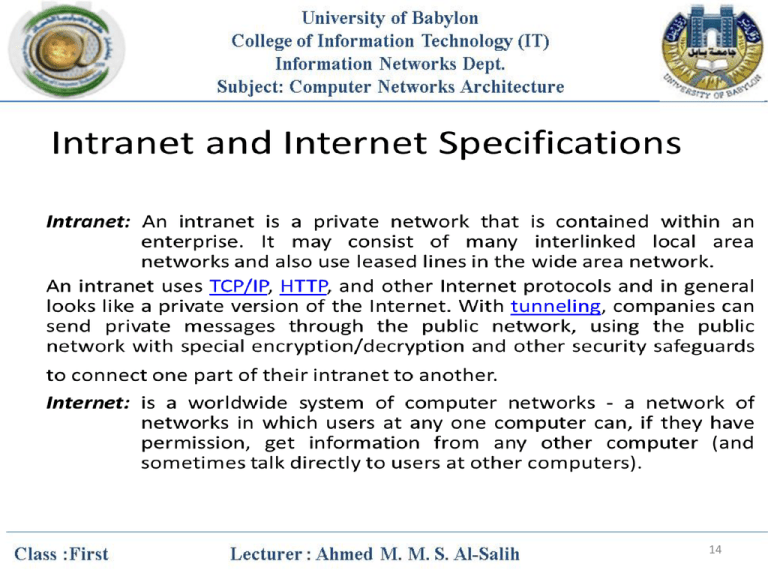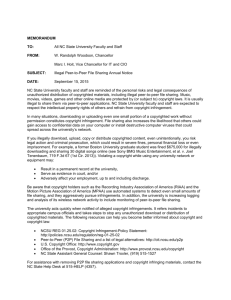14
advertisement

14 A network is a group of connected, communicating devices such as computers and printers. An internet (note the lowercase i) is two or more networks that can communicate with each other. The most notable internet is called the Internet (uppercase I ), composed of hundreds of thousands of interconnected networks. Private individuals as well as various organizations such as government agencies, schools, research facilities, corporations, and libraries in more than 100 countries use the Internet. Millions of people are users. Yet this extraordinary communication system only came into being in 1969. Standards Creation Committees International Standards Organization (ISO). The International Standards Organization (ISO; also referred to as the International Organization for Standardization). it aims to facilitate the international exchange of goods and services by providing models for compatibility, improved quality, increased productivity, and decreased prices.1 15 American National Standards Institute (ANSI). is a completely private ANSI’s expressed aims include serving as the national coordinating institution for voluntary standardization in the United States. Institute of Electrical and Electronics Engineers (IEEE). The Institute of Electrical and Electronics Engineers (IEEE) is the largest professional engineering society in the world. International in scope, it aims to advance theory, creativity, and product quality in the fields of electrical engineering, electronics, and radio as well as in all related branches of engineering. Electronic Industries Association (EIA). Aligned with ANSI, the Electronic Industries Association (EIA) is a nonprofit organization devoted to the promotion of electronics manufacturing concerns. Its activities include public awareness education and lobbying efforts in addition to standards development. In the field of information technology, the EIA has made significant contributions by defining physical connection interfaces and electronic signaling specifications for data communications. 16 Application and Services The Client/Server model Peer to Peer (P2P) Model P2P Networks P2P Applications 17 1- The Client/Server model In the client/server model, the device requesting the information is called a client and the device responding to the request is called a server. Client and server processes are considered to be in the Application layer. The client begins the exchange by requesting data from the server, which responds by sending one or more streams of data to the client. Application layer protocols describe the format of the requests and responses between clients and servers. In addition to the actual data transfer, this exchange may also require control information, such as user authentication and the identification of a data file to be transferred. One example of a client/server network is a corporate environment where employees use a company e-mail server to send, receive and store e-mail. The e-mail client on an employee computer issues a request to the e-mail server for any unread mail. The server responds by sending the requested e-mail to the client. In a general networking context, any device that responds to requests from client applications is functioning as a server. A server is usually a computer that contains information to be shared with many client systems. For example, web pages, documents, databases, pictures, video, and audio files can all be stored on a server and delivered to requesting clients. In other cases, such as a network printer, the print server delivers the client print requests to the specified printer. 18 19 2- The Peer-to-Peer Model In addition to the client/server model for networking, there is also a peer-to-peer model. Peer-to-peer networking involves two distinct forms: peer-to-peer network design and peer-to-peer applications (P2P). Both forms have similar features but in practice work very differently. 2-1 Peer-to-Peer Networks In a peer-to-peer network, two or more computers are connected via a network and can share resources (such as printers and files) without having a dedicated server. Every connected end device (known as a peer) can function as either a server or a client. One computer might assume the role of server for one transaction while simultaneously serving as a client for another. The roles of client and server are set on a per request basis. A simple home network with two connected computers sharing a printer is an example of a peer-to-peer network. Unlike the client/server model, which uses dedicated servers, peer-to-peer networks decentralize the resources on a network. Instead of locating information to be shared on dedicated servers, information can be located anywhere on any connected device. Most of the current operating systems support file and print sharing without requiring additional server software. Because peer-to-peer networks usually do not use centralized user accounts, permissions, or monitors, it is difficult to enforce security and access policies in networks containing more than just a few computers. User accounts and access rights must be set individually on each peer device. 20 21 2-2 Peer-to-Peer Applications A peer-to-peer application (P2P), unlike a peer-to-peer network, allows a device to act as both a client and a server within the same communication. In this model, every client is a server and every server a client. Both can initiate a communication and are considered equal in the communication process. However, peer-to-peer applications require that each end device provide a user interface and run a background service. When you launch a specific peer-to-peer application it invokes the required user interface and background services. After that the devices can communicate directly. Some P2P applications use a hybrid system where resource sharing is decentralized but the indexes that point to resource locations are stored in a centralized directory. In a hybrid system, each peer accesses an index server to get the location of a resource stored on another peer. The index server can also help connect two peers, but once connected, the communication takes place between the two peers without additional communication to the index server. Peer-to-peer applications can be used on peer-to-peer networks, client/server networks, and across the Internet. 22 23 24 25


